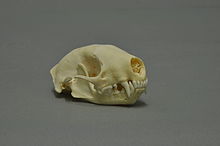シマスカンク
| シマスカンク | |||||||||||||||||||||||||||
|---|---|---|---|---|---|---|---|---|---|---|---|---|---|---|---|---|---|---|---|---|---|---|---|---|---|---|---|
 シマスカンク Mephitis mephitis
| |||||||||||||||||||||||||||
| 保全状況評価[1] | |||||||||||||||||||||||||||
| LEAST CONCERN (IUCN Red List Ver.3.1 (2001)) 
| |||||||||||||||||||||||||||
| 分類 | |||||||||||||||||||||||||||
| |||||||||||||||||||||||||||
| 学名 | |||||||||||||||||||||||||||
| Mephitis mephitis (Schreber, 1776)[2] | |||||||||||||||||||||||||||
| シノニム[2] | |||||||||||||||||||||||||||
|
Viverra mephitis Schreber, 1776 | |||||||||||||||||||||||||||
| 和名 | |||||||||||||||||||||||||||
| シマスカンク[3] | |||||||||||||||||||||||||||
| 英名 | |||||||||||||||||||||||||||
| Striped skunk[2] | |||||||||||||||||||||||||||
 生息域
|
シマスカンク(Mephitis mephitis)は、哺乳綱食肉目スカンク科スカンク属に分類される哺乳類。スカンク属の模式種[2][4]。北アメリカ(カナダ南部、アメリカ合衆国、メキシコ北部)に分布[2]。
形態
[編集]


頭胴長(体長)33-45cm[3]、尾長18.4-39.3cm[2]。体重1.8-4.5kg(稀に5.5kgになるものもある)[5]。成獣の雄は雌より10%大きい[5]。
小さな円錐形の頭と長く重い毛皮で覆われた尾を持つ。体は頑丈な造りで、手足は短い[6]。
毛皮の色とパターンは個体によって大きく異なるが、一般的には黒をベースに、白い筋が頭から尻と尾まで続く(白い筋は途中、肩で分かれる)[7][5]。胸に白い斑点があったり、前肢の外面に白い縞模様がある個体もある[5]。しばしば灰色やクリーム色への突然変異が起こる[8]。
肢はむき出しの足裏をもつ板状で[5]、ブタバナスカンクほど広くも平らでもない[6]。前肢には穴を掘るのに適した5本の湾曲した長い爪があり、後肢の爪は短くてまっすぐである[5]。
臭液
[編集]他のスカンク同様、捕食者を追い払うために、悪臭を放つ液体で満たされた臭腺を持つ。2つの発達した臭腺を持ち、各15mlの臭液が入っている[9]。これを噴射して捕食者への化学的防御とする[10]。臭液は油分に富み、黄色く、強力な臭気のチオールの混合物で構成されており、数メートルの距離へ噴霧することができる。
生態
[編集]温帯林、農地、市街地などに生息[7]。繁殖期や冬期を除いて単独性で、夕方や夜間に活動する[3]。一夫多妻制で、雑食性[11]。北部の個体群は冬眠を行う[12]。 猛禽類を除いて、自然界の捕食者がほとんどいない[13]。
人間との関係
[編集]毛皮のために捕獲され、また、飼育されて[11]、ペットとして飼われてきた[14]、という人間との関係において長い歴史を持つ。現在は低危険種に分類されており、人為的に改変された環境にもよく適応している[1]。北米の動物の中で最も有名なものの一つで、漫画や児童書で人気のある種である[15]。アメリカ合衆国では狂犬病の主な媒介者となっている[7]。
脚注
[編集]- ^ a b Helgen, K. & Reid, F. (2016). “Mephitis mephitis”. IUCN Red List of Threatened Species 2016: e.T41635A45211301. doi:10.2305/IUCN.UK.2016-1.RLTS.T41635A45211301.en 2022年10月1日閲覧。.
- ^ a b c d e f Julia Wade-Smith & B. J. Verts, “Mephitis mephitis,” Mammalian Species, No. 173, American Society of Mammalogists, 1982, Pages 1–7.
- ^ a b c 斉藤勝・伊東員義・細田孝久・西木秀人「イタチ科の分類」、今泉吉典監修『世界の動物 分類と飼育 2(食肉目)』東京動物園協会、1991年、42-46頁。
- ^ W. Christopher Wozencraft, “Order Carnivora,” In: Don E. Wilson & DeeAnn M. Reeder (eds.), Mammal Species of the World (3rd ed.), Johns Hopkins University Press, 2005, Pages 532-628.
- ^ a b c d e f Rosatte, R. & Lawson, S. (2003). Skunks. In G. Feldhamer, B. Thompson, & J. Chapman (Eds.), Wild Mammals of North America; biology, management and conservation (2nd ed.) Baltimore: Johns Hopkins University Press. pp. 692-707.
- ^ a b Coues, E. (1877). Fur-bearing animals: a monograph of North American Mustelidae, in which an account of the wolverene, the martens or sables, the ermine, the mink and various other kinds of weasels, several species of skunks, the badger, the land and sea otters, and numerous exotic allies of these animals, is contributed to the history of North American mammals. Geological and Geographical Survey of the Territories (U.S.). pp. 195-235.
- ^ a b c ジュリエット・クラットン=ブロック(2005)『ネイチャー・ハンドブック 世界哺乳類図鑑』新樹者, 256-257頁
- ^ Seton, E. T. (1909). Life-histories of northern animals : an account of the mammals of Manitoba. New York City: Scribner. pp. 966-994
- ^ Merriam, C. H. (1886). The mammals of the Adirondack region, northeastern New York. New York : Henry Holt and Co. pp. 69-87.
- ^ Berenbaum, M. R. (1995-01-03). “The chemistry of defense: theory and practice” (英語). Proceedings of the National Academy of Sciences 92 (1): 2–8. Bibcode: 1995PNAS...92....2B. doi:10.1073/pnas.92.1.2. ISSN 0027-8424. PMC 42807. PMID 7816816.
- ^ a b Lantz, D. E. (1923). Economic value of North American skunks. Washington, D.C.: U.S. Dept. of Agriculture.
- ^ スミソニアン協会監修(2012)『世界博物学大図鑑』東京書籍, 574頁
- ^ Wade-Smith, J. & Verts, B. J. (1982). "Mephitis mephitis" (PDF). Mammalian Species 173 : 1–7.
- ^ Cipriani, D. (2011) "Skunks are affectionate, intelligent pets for owners who offer the proper care." Critters USA. pp. 2-6
- ^ Feinstein, J. (2011). Field Guide to Urban Wildlife. Stackpole Books. p. 67. ISBN 0811705854
